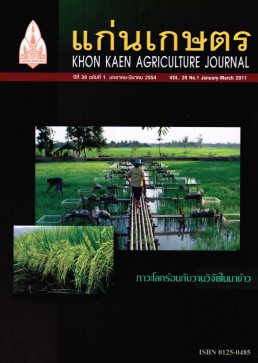Effects of Sowing Depths on Growth and Rooting Patterns of Cowpea and Mungbean in a Deep Sand with Shallow Water Table
Main Article Content
บทคัดย่อ
In some dry-season cropping areas of northeast Thailand, farmers can grow selected annual legumes without irrigation by deep seeding. This cropping system seems to depend on capillary water rising from a shallow water table and seems to be suitable for peanut and cowpea but not other legumes. Seedlings planted by deep seeding might produce more roots under the seed position and could facilitate plants to absorb more water in deep soil because their roots were closer to water table. The present experiment was set up to investigate the differences of growth and rooting patterns between cowpea and mungbean planted at different sowing depths in a sandy soil with a shallow water table. Cowpea and mungbean seeds were sown in soil columns either shallow (~5 cm) or deep (~15 cm) with wet or dry soil over the seeding position. Shoot dry weight of legume plant did not differ consistently between seeding depths but shallow seeding generally increased root: shoot ratio and root length at 6 WAS. Percentage of root length in subsoil (>15 cm) ranged from 21 % to 80 % and 76 % to 99 % for legume plant after shallow and deep seeding, respectively. However, growth of legume plant after shallow and deep seeding did not significantly differ in this study because water was non-limiting for plant growth throughout the 6 weeks growth period. By contrast the percentage of roots of deep-seeded legumes in subsoil increased to 46%. Cowpea and mungbean with relatively dry soil above the seeding position had a bigger and deeper root system than the wet soil in both species. Cowpea had greater shoot growth than mungbean and its root system was bigger and deeper than mungbean. Greater depth of cowpea roots increased access to soil moisture supplied in deep soil layers due to the standing water table. This characteristic might explain the suitability of cowpea for growing on sand soils in the dry season without irrigation.


